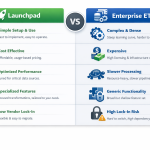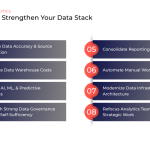
Take a look at the combinations of metrics and dimensions we recommend for the most common GA4 reports, including traffic, events, demographics, e-commerce, and page performance.
Google Analytics 4 launched back in 2020, but many users are still getting used to the ins and outs of the new platform. GA4's predecessor, Universal Analytics, relied heavily on cookies to track user behavior, whereas the new version is based on events instead. Events add a new level of flexibility for analysts and marketers, but this mindset shift can take some getting used to.
To make your life easier, we've compiled the most common combinations of metrics and dimensions that we see in GA4 reports. Configuring your reports to include these metrics and dimensions will ensure that you have the data you need to identify trends, uncover insights, and create effective visualizations.
If you need any help pulling these reports from GA4 and transferring your data to the storage of your choice, then be sure to check out Launchpad — an intuitive, no-code application that takes care of the entire ETL process (extract, transfer, and load) for you.
Traffic and Performance
The Traffic and Performance schema is by far our most popular. The included dimensions and metrics can be found on almost any e-commerce-based dashboard.
Dimensions
- Date (date)
- Session source / medium (string)
- Session campaign (string)
- Device category (string)
- Event name (string)
- Event count (string)
Metrics
- Sessions (integer)
- Engaged sessions (integer)
- Average session duration (float - seconds)
- New users (integer)
- Total users (integer)
- Purchase revenue (float)
- Transactions (integer)
Events Detail
If your site is configured to track events, you'll want to add this schema to the list of data you wish to transfer.
Dimensions
- Date (date)
- Device category (string)
- Link URL (string)
- Outbound (boolean)
- Is conversion event (boolean)
- Page path (string)
- Event name (string)
- Event count (string)
Metrics
- Add-to-carts (integer)
- Checkouts (integer)
- Ecommerce purchases (integer)
- Item list views (integer)
- Item list clicks (integer)
- Item views (integer)
- Purchase revenue (float)
- Total revenue (float)
- Conversions (integer)
- Event value (float)
Page Performance
The page performance schema will transfer information about the most widely viewed pages on your site and the corresponding engagement.
Dimensions
- Date (date)
- Full page URL (string)
- Event name (string)
- Event count (string)
- Platform (string)
Metrics
- Screen page views (integer)
- Total Users (integer)
- User engagement duration (integer)
- Engaged sessions (integer)
- Sessions (integer)
- Conversions (integer)
Demographics
If your Google Analytics account is configured to track demographic information about your users, you'll want to include this schema in your data transfers. This data will allow you to view your user age, gender, and interest data over time. Demographic data only persists through your data retention window, which defaults to two months and has a maximum of fourteen months. If you wish to query data past the two-month default, you will need to change the data retention preference in your Google Analytics 4 settings.
Dimensions
- Date (date)
- User gender (string)
- User age bracket (string)
- Device category (string)
- Event count (string)
Metrics
- Sessions (integer)
- Engaged sessions (integer)
- Total revenue (float)
- Transactions (integer)
- Conversions (integer)
Geographic
The geographic schema will transfer the data specific to your user locale.
Dimensions
- Date (string)
- Contient (string)
- Country (string)
- Region (string)
- City (string)
- Session source / medium (string)
- Session campaign (string)
- Event name (string)
Metrics
- Sessions (integer)
- Engaged sessions (integer)
- Event count (integer)
- New users (integer)
- Total users (integer)
- Transactions (integer)
- Total revenue (float)
Landing Page
Understanding the performance of landing pages that are used to enter your site is crucial to your web content and SEO strategies. Transferring this data will ensure you have the ability to look back at previous versions of your site and landing pages and understand the changes in performance over time.
Dimensions
- Date (string)
- Landing page (string)
- Device category (string)
- Session source / medium (string)
- Session campaign (string)
Metrics
- Sessions (integer)
- Engaged sessions (integer)
- Total users (integer)
- New users (integer)
- Conversions (integer)
- Transactions (integer)
- Total revenue (float)
Users
The user report in GA4 can be difficult to work with because Google does not expose user IDs or session IDs in the API. For the most accurate measurement of sessions and users, it is best to use the native Google BigQuery export feature and COUNT users and sessions based on app or system IDs. If you are going to use the API to measure users and sessions, we recommend batching the requests by calendar month to obtain a value that is near the actual.
Dimensions
- Date (date)
- Session source / medium (string)
- Session campaign (string)
- Device category (string)
- New / returning (string)
Metrics
- Sessions (integer)
- Engaged sessions (integer)
- Total users (integer)
- New users (integer)
- Active users (integer)
- 1-day active users (integer)
- 7-day active users (integer)
- 28-day active users (integer)
E-commerce
The following schema is only used for websites with e-commerce capabilities. The dimensions and metrics outlined below will provide a view into all of your transactions over time.
Dimensions
- Date (date)
- Transaction ID (string)
- Session source / medium (string)
- Session campaign (string)
- Device category (string)
- Continent (string)
- Country (string)
- Region (string)
- City (string)
Metrics
- Transactions (integer)
- Total revenue (float)
- Add-to-carts (integer)
- Checkouts (integer)
- Ecommerce purchases (integer)
- Item list views (integer)
- Item list clicks (integer)
- Item views (integer)
- Tax amount (float)
- Shipping amount (float)
Items
The items object is new to Google Analytics, and it contains granular data about each of your purchases. Information in the items object cannot be combined with parent-level dimensions such as device, source, or medium. We recommend using the GA4 Dimensions and Metrics Explorer (https://ga-dev-tools.google/ga4/dimensions-metrics-explorer/) for more information on the valid dimension and metric combinations that you can use with Looker Studio and the GA4 API.
Dimensions
- Date (date)
- Transaction ID (string)
- Item brand (string)
- Item ID (string)
- Item name (string)
- Item list name (string)
- Item category (string)
- Item category 2 (string)
Metrics
- Item revenue (float)
- Items added to cart (integer)
- Items checked out (integer)
- Item purchase quantity (integer)
- Items viewed (integer)
- Items viewed in list (integer)
- Items clicked in list (integer)
Let Launchpad Do the Work for You
Extracting and archiving the correct data is necessary to ensure a steady stream of quality insights to guide your business. If you need any help setting up your GA4 reporting, the experts will be happy to introduce you to Launchpad — our no-code ETL (extract, transform, and load) platform that does all the work for you.




